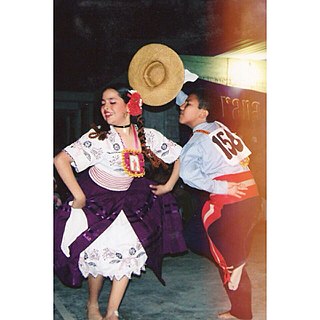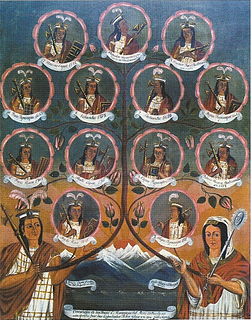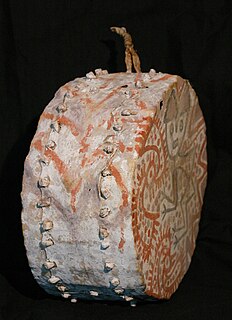
Andean music is a group of styles of music from the Andes region in South America.
The Music of Peru is an amalgamation of sounds and styles drawing on Peru's Andean, Spanish, and African roots. Andean influences can perhaps be best heard in wind instruments and the shape of the melodies, while the African influences can be heard in the rhythm and percussion instruments, and European influences can be heard in the harmonies and stringed instruments. Pre-Columbian Andean music was played on drums and string instruments, like the European pipe and tabor tradition. Andean tritonic and pentatonic scales were elaborated during the colonial period into hexatonic, and in some cases, diatonic scales.

Amazonas is a department and region in northern Peru bordered by Ecuador on the north and west, Cajamarca on the west, La Libertad on the south, and Loreto and San Martín on the east. Its capital is the city of Chachapoyas.

Apurímac is a department and region in southern-central Peru. It is bordered on the east by the Cusco Region, on the west by the Ayacucho Region, and on the south by the Arequipa and Ayacucho regions. The region's name originates from the Quechua language and means "where the gods speak" in reference to the many mountains of the region that seem to be talking to each other.

La Libertad is a region in northwestern Peru. Formerly it was known as the Department of La Libertad. It is bordered by the Lambayeque, Cajamarca and Amazonas regions on the north, the San Martín Region on the east, the Ancash and Huánuco regions on the south and the Pacific Ocean on the west. Its capital is Trujillo, which is the nation's third biggest city. The region's main port is Salaverry, one of Peru's largest ports. The name of the region is Spanish for "freedom" or "liberty"; it was named in honor of the Intendencia of Trujillo's proclaiming independence from Spain in 1820 and fighting for that. It is the ninth smallest department in Peru, but it is also its second most populous department after Piura and its second most densely populated department after Lambayeque.

The Chachapoyas, also called the "Warriors of the Clouds", was a culture of the Andes living in the cloud forests of the southern part of the Department of Amazonas of present-day Peru. The Inca Empire conquered their civilization shortly before the Spanish conquest in the 16th century. At the time of the arrival of the conquistadors, the Chachapoyas were one of the many nations ruled by the Incas, although their incorporation had been difficult due to their constant resistance to Inca troops.

Cueca is a family of musical styles and associated dances from Chile, Argentina, and Bolivia. In Chile, the cueca holds the status of national dance, where it was officially declared as such by the Pinochet dictatorship on September 18, 1979.
Música criolla or canción criolla is a varied genre of Peruvian music that exhibits influences from European, African and Andean music. The genre's name reflects the coastal culture of Peru, and the local evolution of the term criollo, a word originally denoting high-status people of full Spanish ancestry, into a more socially inclusive element of the nation.

Chinchay Suyu or Chinchasuyu was the northwestern provincial region of the Tawantin Suyu, or Inca Empire. The most populous suyu, Chinchasuyu encompassed the former lands of the Chimú Empire and much of the northern Andes. At its largest extent, the suyu extended through much of modern Ecuador and just into modern Colombia. Along with Antisuyu, it was part of the Hanan Suyukuna or "Upper Quarters" of the empire.

Quechua people or Quecha people, may refer to any of the aboriginal people of South America who speak the Quechua languages, which originated among the Indigenous people of Peru. Although most Quechua speakers are native to Peru, there are some significant populations in Ecuador, Bolivia, Chile, Colombia, and Argentina.

Marinera is a courtship dance that originated along the coastal regions of Peru. Marinera is a graceful and romantic couple's dance that uses handkerchiefs as props. The dance is a mix of Spanish contradanza and Andean zamacueca and is an elegant and stylized reenactment of a courtship, and it shows a blend of the different cultures of Peru. The dance itself has gained recognition throughout South America and is known as the most prominent traditional dance of Peru. The city of Trujillo has been recognized as the national birthplace of the marinera since 1986. The Marinera Festival, a cultural event dedicated to marinera held in Trujillo, has held annual competitions of the dance since 1960. In 2012, the Congress of Peru observed nationally October 7 as a commemorative day for the marinera.

Tondero is a dance and guitar rhythm from Peru that developed in the country's northern coastal region (Piura–Lambayeque).

The Incas were most notable for establishing the Inca Empire in pre-Columbian America, which was centered in what is now Peru from 1438 to 1533, and represented the height of the Inca civilization. The Inca state was known as the Kingdom of Cuzco before 1438. Over the course of the Inca Empire, the Inca used conquest and peaceful assimilation to incorporate the territory of modern-day Peru, followed by a large portion of western South America, into their empire, centered on the Andean mountain range. However, shortly after the Inca Civil War, the last Sapa Inca (emperor) of the Inca Empire was captured and killed on the orders of the conquistador Francisco Pizarro, marking the beginning of Spanish rule. The remnants of the empire retreated to the remote jungles of Vilcabamba and established the small Neo-Inca State, which was conquered by the Spanish in 1572.

The tinya (Quechua) or kirki (Quechua) is a percussion instrument, a small handmade drum of leather which is used in the traditional music of the Andean region, particularly Peru. The drum dates to the pre-Columbian era, and is used in traditional Peruvian dances, notably in Los Danzantes de Levanto where it is played by one person simultaneously with the antara, a type of panflute; that instrument combination is similar to the worldwide tradition of the pipe and tabor.
Los Danzantes de Levanto is a typical dance from the Amazonas Region, Peru. Levanto is a little town that is approximately 10 km far from Chachapoyas, whose "dancers" form a showy group of thirteen cholos, very well trained, that are guided by a "pifador" that plays the antara and a small drum called tinya simultaneously.
Peruvians are the people of Peru. There were Andean and coastal ancient civilizations like Caral, who inhabited Peruvian territory for several millennia before the Spanish conquest in the 16th century; Peruvian population decreased from an estimated 5–9 million in the 1520s to around 600,000 in 1620 mainly because of infectious diseases. Spaniards and Africans arrived in large numbers in 1532 under colonial rule, mixing widely with each other and with Native Peruvians. During the Republic, there has been a gradual immigration of European people. Chinese and Japanese arrived in large numbers at the end of the 19th century.

The Danza de las tijeras is an original dance of Chanka origin from the south of the Andes, in Peru. The dance consists of two or more dancers, followed by their respective orchestras of a violin and a harp. The dancers dance in turns, doing explicit moves and challenging steps, such as dancing with just one foot.
The Zamacueca is an ancient colonial dance and music that originated in the Viceroyalty of Peru, taking its roots from Spanish, and Andean rhythms. Although currently the dance is not widely popular, several dance institutions in places such as Peru still dedicate part of their time to teaching Zamacueca.

Chinchaypujio is one of nine districts of the Anta Province in Peru and about 2 hours outside of Cusco. Its capital, Chinchaypujio, hosts a weekly market (Mercado Ferial de Chinchaypujio) as well as the regional government. The district is home to 9 communities: Chinchaypujio, Ocra, Paucarccoto, Parcotica, Waccahualla, Huancancalla, Sumaru, Pantipata and Huamumayo. In its southernmost part, the Apurímac River crosses the district; a major trade road connecting the Cuzco Department with the Department of Apurímac crosses through the entire district from north to south.














